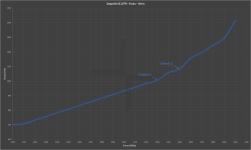Soldato
Ryzen 3 2200G and Ryzen 5 2400G
https://hexus.net/tech/reviews/cpu/114962-amd-ryzen-5-2400g-ryzen-3-2200g/
https://techreport.com/review/33235/amd-ryzen-3-2200g-and-ryzen-5-2400g-apus-reviewed
http://www.pcgameshardware.de/Ryzen...-APU-Gaming-Benchmarks-Ryzen-3-2200G-1249754/
https://www.sweclockers.com/test/25...och-ryzen-3-2200g-raven-ridge-med-vega-grafik
https://bit-tech.net/reviews/tech/cpus/amd-ryzen-5-2400g-and-ryzen-3-2200g-reviews/1/
https://www.hardware.fr/news/15356/amd-lance-apu-ryzen-5-2400g-ryzen-3-2200g.html
https://www.anandtech.com/show/12425/marrying-vega-and-zen-the-amd-ryzen-5-2400g-review
https://hothardware.com/reviews/amd-raven-ridge-ryzen-3-2200g-and-ryzen-5-2400g-am4-apu-review
http://www.trustedreviews.com/reviews/amd-ryzen-5-2400g-2200g
https://www.forbes.com/sites/antony...ate-choice-for-budget-pc-gaming/#37279be05f7a
https://www.pcper.com/reviews/Processors/AMD-Ryzen-5-2400G-and-Ryzen-3-2200G-Review-Return-APU
https://www.eteknix.com/ryzen-with-vega-60-fps-budget/
http://www.hardwarecanucks.com/foru...6-amd-ryzen-5-2400g-ryzen-3-2200g-review.html
https://nl.hardware.info/reviews/7933/amd-ryzen-5-2400g-a-ryzen-3-2200g-review-mmo-kampioenen
https://www.hardwareluxx.de/index.p...-3-2200g-im-test-die-luecke-ist-gestopft.html
https://overclock3d.net/reviews/cpu...idge_ryzen_3_2200g_and_ryzen_5_2400g_review/1
http://lab501.ro/procesoare-chipseturi/raven-ridge-amd-ryzen-5-2400g-ryzen-3-2200g-part-ii-cpu
https://www.tweaktown.com/reviews/8520/amd-ryzen-3-2200g-5-2400g-review/index.html
https://wasd.ro/hardware-reviews/mobo-cpu/amd-ryzen-3-2200g-ryzen-5-2400g-review-partea-1-cpu/
https://www.techspot.com/review/1574-amd-ryzen-5-2400g-and-ryzen-3-2200g/
https://www.pcworld.com/article/325...view-ryzen-plus-vega-saves-budget-gamers.html
http://www.trustedreviews.com/reviews/amd-ryzen-5-2400g-2200g
https://www.kitguru.net/components/...and-ryzen-3-2200g-apus-code-name-raven-ridge/
https://hothardware.com/reviews/amd-raven-ridge-ryzen-3-2200g-and-ryzen-5-2400g-am4-apu-review
https://translate.google.co.uk/translate?sl=auto&tl=en&js=y&prev=_t&hl=en&ie=UTF-8&u=https://www.computerbase.de/2018-02/ryzen-3-2200g-5-2400g-test-amd-raven-ridge/&edit-text=
https://translate.google.co.uk/translate?sl=auto&tl=en&js=y&prev=_t&hl=en&ie=UTF-8&u=https://www.ht4u.net/reviews/2018/amd_ryzen_5_2400g_und_ryzen_3_2200g_raven_ridge/&edit-text=
http://www.eurogamer.net/articles/digitalfoundry-2018-ryzen-3-2200-g-ryzen-5-2400g-review
https://www.gamersnexus.net/hwreviews/3261-r3-2200g-r5-2400g-review-gaming-benchmarks-vs-gt-1030
Ryzen 5 2400G
http://www.tomshardware.com/reviews/amd-ryzen-5-2400g-zen-vega-cpu-gpu,5467.html#xtor=RSS-100
https://www.techpowerup.com/reviews/AMD/Ryzen_5_2400G_Vega_11/
https://www.guru3d.com/articles-pages/amd-ryzen-5-2400g-review,1.html
https://www.extremetech.com/computi...best-blend-cpu-gpu-performance-weve-ever-seen
https://www.pcgamesn.com/amd-ryzen-5-2400g-review-benchmarks
Ryzen 3 2200G
https://www.guru3d.com/articles-pages/amd-ryzen-3-2200g-review,1.html
https://www.techpowerup.com/reviews/AMD/Ryzen_3_2200G_Vega_8/
http://www.tomshardware.com/reviews/amd-ryzen-3-2200g-raven-ridge-cpu,5472.html
BLCK overclocking upto 4.56GHZ
https://www.pcgamesn.com/amd-raven-ridge-overclocking
Ryzen 3 2200G and Ryzen 5 2400G video reviews
https://hexus.net/tech/reviews/cpu/114962-amd-ryzen-5-2400g-ryzen-3-2200g/
https://techreport.com/review/33235/amd-ryzen-3-2200g-and-ryzen-5-2400g-apus-reviewed
http://www.pcgameshardware.de/Ryzen...-APU-Gaming-Benchmarks-Ryzen-3-2200G-1249754/
https://www.sweclockers.com/test/25...och-ryzen-3-2200g-raven-ridge-med-vega-grafik
https://bit-tech.net/reviews/tech/cpus/amd-ryzen-5-2400g-and-ryzen-3-2200g-reviews/1/
https://www.hardware.fr/news/15356/amd-lance-apu-ryzen-5-2400g-ryzen-3-2200g.html
https://www.anandtech.com/show/12425/marrying-vega-and-zen-the-amd-ryzen-5-2400g-review
https://hothardware.com/reviews/amd-raven-ridge-ryzen-3-2200g-and-ryzen-5-2400g-am4-apu-review
http://www.trustedreviews.com/reviews/amd-ryzen-5-2400g-2200g
https://www.forbes.com/sites/antony...ate-choice-for-budget-pc-gaming/#37279be05f7a
https://www.pcper.com/reviews/Processors/AMD-Ryzen-5-2400G-and-Ryzen-3-2200G-Review-Return-APU
https://www.eteknix.com/ryzen-with-vega-60-fps-budget/
http://www.hardwarecanucks.com/foru...6-amd-ryzen-5-2400g-ryzen-3-2200g-review.html
https://nl.hardware.info/reviews/7933/amd-ryzen-5-2400g-a-ryzen-3-2200g-review-mmo-kampioenen
https://www.hardwareluxx.de/index.p...-3-2200g-im-test-die-luecke-ist-gestopft.html
https://overclock3d.net/reviews/cpu...idge_ryzen_3_2200g_and_ryzen_5_2400g_review/1
http://lab501.ro/procesoare-chipseturi/raven-ridge-amd-ryzen-5-2400g-ryzen-3-2200g-part-ii-cpu
https://www.tweaktown.com/reviews/8520/amd-ryzen-3-2200g-5-2400g-review/index.html
https://wasd.ro/hardware-reviews/mobo-cpu/amd-ryzen-3-2200g-ryzen-5-2400g-review-partea-1-cpu/
https://www.techspot.com/review/1574-amd-ryzen-5-2400g-and-ryzen-3-2200g/
https://www.pcworld.com/article/325...view-ryzen-plus-vega-saves-budget-gamers.html
http://www.trustedreviews.com/reviews/amd-ryzen-5-2400g-2200g
https://www.kitguru.net/components/...and-ryzen-3-2200g-apus-code-name-raven-ridge/
https://hothardware.com/reviews/amd-raven-ridge-ryzen-3-2200g-and-ryzen-5-2400g-am4-apu-review
https://translate.google.co.uk/translate?sl=auto&tl=en&js=y&prev=_t&hl=en&ie=UTF-8&u=https://www.computerbase.de/2018-02/ryzen-3-2200g-5-2400g-test-amd-raven-ridge/&edit-text=
https://translate.google.co.uk/translate?sl=auto&tl=en&js=y&prev=_t&hl=en&ie=UTF-8&u=https://www.ht4u.net/reviews/2018/amd_ryzen_5_2400g_und_ryzen_3_2200g_raven_ridge/&edit-text=
http://www.eurogamer.net/articles/digitalfoundry-2018-ryzen-3-2200-g-ryzen-5-2400g-review
https://www.gamersnexus.net/hwreviews/3261-r3-2200g-r5-2400g-review-gaming-benchmarks-vs-gt-1030
Ryzen 5 2400G
http://www.tomshardware.com/reviews/amd-ryzen-5-2400g-zen-vega-cpu-gpu,5467.html#xtor=RSS-100
https://www.techpowerup.com/reviews/AMD/Ryzen_5_2400G_Vega_11/
https://www.guru3d.com/articles-pages/amd-ryzen-5-2400g-review,1.html
https://www.extremetech.com/computi...best-blend-cpu-gpu-performance-weve-ever-seen
https://www.pcgamesn.com/amd-ryzen-5-2400g-review-benchmarks
Ryzen 3 2200G
https://www.guru3d.com/articles-pages/amd-ryzen-3-2200g-review,1.html
https://www.techpowerup.com/reviews/AMD/Ryzen_3_2200G_Vega_8/
http://www.tomshardware.com/reviews/amd-ryzen-3-2200g-raven-ridge-cpu,5472.html
BLCK overclocking upto 4.56GHZ
https://www.pcgamesn.com/amd-raven-ridge-overclocking
Ryzen 3 2200G and Ryzen 5 2400G video reviews
Last edited:






